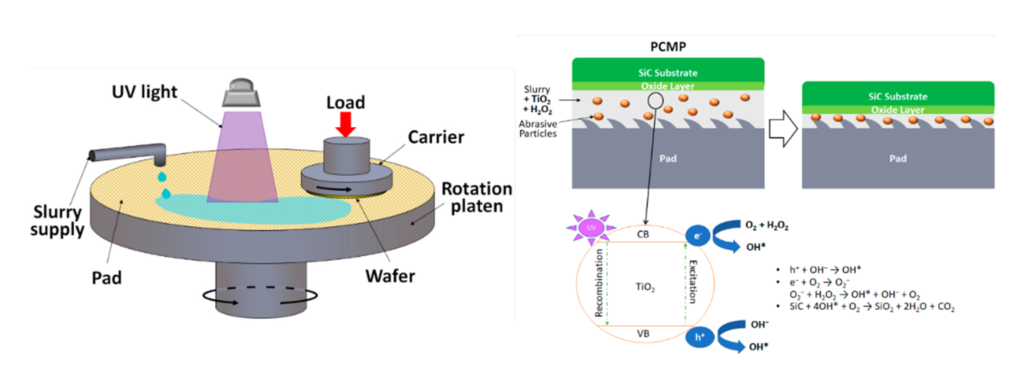Chi-Hsiang Hsieh, Che-Yuan Chang, Yi-Kai Hsiao, Chao-Chang A. Chen, Chang-Ching Tu and Hao-Chung Kuo
Micromachines , 13(10), 1752 (2022) — Published in October 2022
ABSTRACT
Chemical mechanical polishing (CMP) is a well-known technology that can produce surfaces with outstanding global planarization without subsurface damage. A good CMP process for Silicon Carbide (SiC) requires a balanced interaction between SiC surface oxidation and the oxide layer removal. The oxidants in the CMP slurry control the surface oxidation efficiency, while the polishing mechanical force comes from the abrasive particles in the CMP slurry and the pad asperity, which is attributed to the unique pad structure and diamond conditioning. To date, to obtain a high-quality as-CMP SiC wafer, the material removal rate (MRR) of SiC is only a few micrometers per hour, which leads to significantly high operation costs. In comparison, conventional Si CMP has the MRR of a few micrometers per minute. To increase the MRR, improving the oxidation efficiency of SiC is essential. The higher oxidation efficiency enables the higher mechanical forces, leading to a higher MRR with better surface quality. However, the disparity on the Si-face and C-face surfaces of 4H- or 6H-SiC wafers greatly increases the CMP design complexity. On the other hand, integrating hybrid energies into the CMP system has proven to be an effective approach to enhance oxidation efficiency. In this review paper, the SiC wafering steps and their purposes are discussed. A comparison among the three configurations of SiC CMP currently used in the industry is made. Moreover, recent advances in CMP and hybrid CMP technologies, such as Tribo-CMP, electro-CMP (ECMP), Fenton-ECMP, ultrasonic-ECMP, photocatalytic CMP (PCMP), sulfate-PCMP, gas-PCMP and Fenton-PCMP are reviewed, with emphasis on their oxidation behaviors and polishing performance. Finally, we raise the importance of post-CMP cleaning and make a summary of the various SiC CMP technologies discussed in this work.

